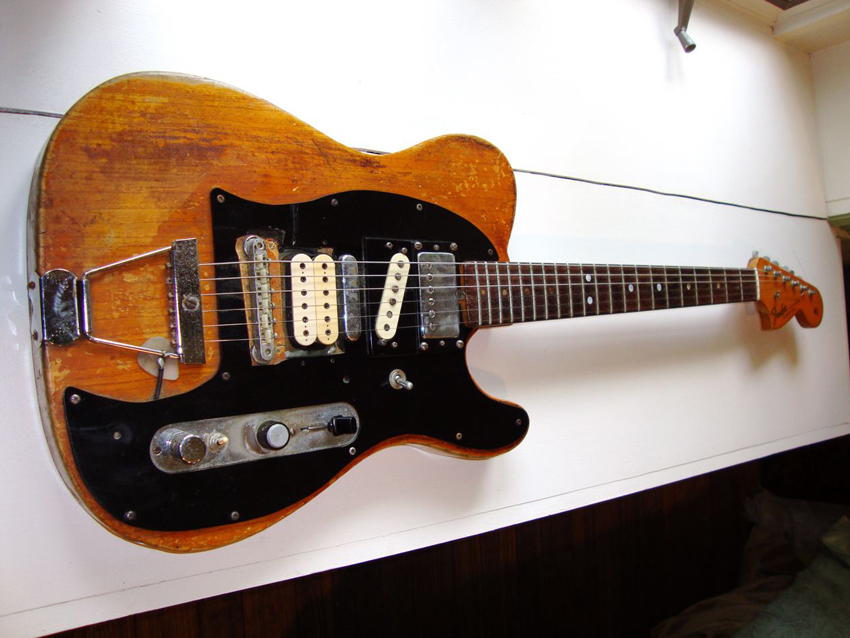“Yes, I know, I have no respect for an instrument. To me, it’s a piece of wood until you make it into a useful tool”: Steve Morse on the time he took power tools to his guitar so he could play a Deep Purple show with a broken wrist
Upper-fret access, the DIY way... Do not try this at home. But as the former Deep Purple guitarist explains, you can't stand on ceremony when you need your guitar to play how you want it to

The summer of 2000 was a wild one for Steve Morse – or at least it was a summer of misadventure. The then 46-year-old guitarist was larking around on a skateboard, fell and broke his wrist, and he had an upcoming tour with Deep Purple fast approaching.
There are a couple of lessons to take from this story. The first, and it’s an obvious one, is do not go on a skateboard, especially when you are in your mid 40s, and especially when you are about to go on tour.
The second is that the fracture of the wrist – a mere flesh wound – did not stop Morse from being on that tour, and judging by the evidence of Deep Purple’s performance at the Montreux Jazz Festival, it barely slowed him down.
Onstage, Morse tore it up on his Ernie Ball Music Man signature guitar as usual, matching the late Jon Lord note for note when the British rock institution stretched its legs and jammed. This was also a summer of double sets, playing with the Steve Morse Band, opening the show for the Dixie Dregs.
The Washington Post was impressed, calling Morse a “Man of steel” for his indefatigability, and reported that Morse asked his osteopath to put him in a cast that would not inhibit his movement. The only sign that he wasn’t 100 per cent match fit was the cast on his left wrist.
But speaking to MusicRadar earlier this month, Morse said that the cast really did impede his movement, and it inspired one of the most drastic mods he has ever made to an electric guitar. If you saw him on that 2000 tour, you might not have noticed. His EBMM Steve Morse signature model looked as it always did, with its unorthodox four-pickup configuration. What we didn’t see was the mod he made to allow him to play like he did.
“I broke my wrist, right before a Purple show and I couldn’t reach some of the notes on the neck with the cast on,” he says. “So I got a grinder and cut down the heel of it to help facilitate that [access] – including the steel plate. I took the steel plate off and ground that down and well…”
Want all the hottest music and gear news, reviews, deals, features and more, direct to your inbox? Sign up here.
And well he made the shows, and the incident tells us pretty much everything we need to know about Morse the guitar player.
This is the player who turned his Fender Telecaster into, well, something else; yes, it’s a Tele with a Stratocaster neck on it, a hybrid we all can recognise, but the electronics had been rerouted and expanded.

Morse was only 11 or 12 when he he started modding guitars, first with his Stratocaster, swapping out the output jack so he could use an old-school plug-in-fuzz device. This was before fuzz pedals were ten-a-penny; before a fuzz guitar plugin meant something digital.
“A friend of mine had one of the first fuzzboxes; it was more like a battery-operated preamp, but it plugged right into the guitar,” said Morse, speaking to MusicRadar in 2012. “I couldn’t plug it into the recessed jack, so I took a piece of an outlet box that had a hole drilled into it, and I put the jack on that. The fuzz sounded pretty cool, I must say, especially to an 11 or 12-year-old kid.”
He never looked back. Morse says he was always “mechanically inclined”. It is in his nature to try fix things himself, or that he would be willing to take anything part on a guitar to make it sound or play like he wants it to.
I will make changes. I'll grind away parts. Even on my current guitar, I ground down the heel when I got a cast
“Yes, I know. I have no respect! I have no respect for an instrument,” he says with a laugh. “No, to me, it’s a piece of wood until you make it into a useful tool, useful for the person. So I will make changes. I'll grind away parts. Even on my current guitar, I ground down the heel when I got a cast.”
It begs the question, what else would Morse change about his Ernie Ball Music Man? In recent years, he has struggled with arthritis. He tells MusicRadar that the condition has changed the way he plays, and this has ramifications for how the guitar has to perform.
“I have had to come up with new way of picking – several new ways – because different bones in my joint have different pain levels when I change the angles,” he says. “I have to practise those different ways of holding the pick, and the different angles, and whether to bend my arm or pick from the elbow. It’s a lot. You have to really, really, really want to play, to deal with the advance of arthritis.”
To help, Morse developed a mute that sits on the nut, and he is presently working on one that would work at the bridge.
I hope they are going to do reissue, and one idea is to make it like mine is now. There have been a few changes
“I think that’s gonna be real good,” he says. “The reason I didn’t perfect it is because I’m using a guitar synth that sits in that position, and it is a tough choice to make between the guitar synth and being able to mute there, so I’ve got work to do still.”
A guitar synth? There’s another mod he has made to his signature model. Morse says maybe in 2007, upon its 40th Anniversary, he and Ernie Ball Music Man will have an update to mark the occasion.
“I hope they are going to do reissue, and one idea is to make it like mine is now,” he says. “There have been a few changes [Laughs]. I’d say, finish-wise, quite a bit has changed, because I’ve played this in typhoons and sweated over it, you know that corrosive kind of sweat burns after 40 years so it looks different.
“And the pickups, I don’t know what changes on a pickup, if it loses magnetism or what from sitting next to other pickups, but maybe the sound is a little different. So I’ve had to measure that. I have a thing that shows magnetism but it doesn’t have a very refined scale. And of course, I can measure impedance of the windings, like anyone can, but those should be exactly the same. And the mutes, the mutes would be the other thing.”
On 14 November, the Steve Morse Band releases Triangulation, its first studio album since 2009, via Music Theories. Featuring guest spots from John Petrucci and Eric Johnson, Triangulation is available to pre-order now. You can read our interview with Steve Morse in full, coming soon to MusicRadar.
Jonathan Horsley has been writing about guitars and guitar culture since 2005, playing them since 1990, and regularly contributes to MusicRadar, Total Guitar and Guitar World. He uses Jazz III nylon picks, 10s during the week, 9s at the weekend, and shamefully still struggles with rhythm figure one of Van Halen’s Panama.
You must confirm your public display name before commenting
Please logout and then login again, you will then be prompted to enter your display name.



